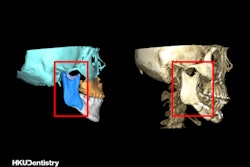
Using tranexamic acid during orthognathic surgery may reduce blood loss and the amount of irrigation fluids needed and increases surgical site quality. The review was published on August 7 in the Journal of Stomatology, Oral and Maxillofacial Surgery.
Tranexamic acid, a synthetic derivative of lysine that works to improve blood clotting, may be an effective adjuvant in decreasing bleeding during jaw surgery, the authors wrote.
“As a result, the potential risk of problems related with considerable blood loss may be minimized, wrote the authors, led by Dr. Feras AlMofreh AlQahtani, an oral and maxillofacial surgery senior house officer in Alkhobar, Saudi Arabia.
To correct irregularities, malalignments, and growth disharmonies of the jaw, surgical procedures, including Le Fort I osteotomies, are often performed. Despite surgery being considered a safe treatment, patients may develop complications, including intraoperative bleeding, that can cause poor surgical site quality and increase a patient's recovery time. Although most bleeding cases are manageable, excessive hemorrhaging can be life-threatening. Ways to manage intraoperative bleeding have been proposed, but no consensus has been reached.
After conducting an electronic database search, seven studies were included in the review. The studies included patients who had undergone orthognathic surgery and were exposed to tranexamic acid. In addition, the researchers considered bleeding during jaw surgery after tranexamic administration and the amount of bleeding.
The review revealed that tranexamic acid significantly decreased the volume of intraoperative blood loss (weighted mean difference [WMD] = 170.24; 95% confidence interval [CI], 99.42 to 241.18; p < 0.001), the authors wrote.
Meanwhile, using tranexamic acid considerably reduced the volume of irrigation fluids (WMD = 229.23; 95% CI, 58.83 to 399.63; p = 0.008). Additionally, tranexamic acid improved the quality of the surgical site (WMD = -1.01; 95% CI, -1.23 to -0.80; p < 0.001), they wrote.
The authors warned that the use of tranexamic acid must be used with caution in patients with acute venous or arterial thrombosis, severe renal impairment, a history of convulsions, disseminated intravascular coagulation, disturbance of color vision, and early pregnancy.
However, the study had multiple shortcomings, including the limited number of available studies. Therefore, more studies are needed to create more detailed criteria for the safe and effective use of tranexamic acid in jaw surgery, they wrote.
“Clinicians should take these findings into consideration when making judgments on the use of TXA in orthognathic surgery,” AlQahtani et al concluded.




















